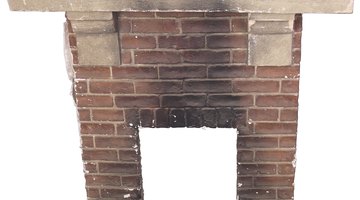Gas Furnace Problems: Black Soot
Natural gas provides a convenient fuel for a home furnace that allows for direct pipe venting from a main source or a storage tank located on the property. Malfunctioning gas furnaces become a serious safety risk, so unusual sounds or smells require prompt investigation.

Regular maintenance prevents most of these issues from occurring or shutting down the furnace when you need it the most.
Air Mixture Problems
When the gas fuel in the furnace doesn't burn completely, soot forms as a byproduct, according to the Dulley Maintenance website. This accumulates inside the combustion chamber and ventilation pipes if the fuel to air mixture is incorrect. A bad heat exchanger allows soot to blow through the home and leaves marks around the air registers. When this part breaks or malfunctions, it also lets dangerous gases like carbon monoxide leak into the home's air supply.
Blocked Vents
All of the unhealthy gases and other byproducts produced by the burning of natural gas vents out of the furnace through a separate pipe, which ensures that all of the heated air distributed to the rest of the home remains safe to breathe. When an animal or bird's nest blocks up the ventilation for your gas furnace, these byproducts are forced out of the furnace and onto the walls or floor around it, says the New Jersey Chimney Sweep Guild.
Repairs
While soot accumulation inside the furnace isn't extremely dangerous, it does pose a few hazards. If a thick coating accumulates, air circulation is impeded and the substance could catch on fire. The black powder shouldn't be inhaled because it causes lung irritation. If it is circulating into the home, call a service technician for a tune-up. Incomplete combustion indicates that fuel is being wasted, so your natural gas energy bills are higher than necessary if the furnace produces soot.
Alternatives
Fine layers of black soot settling on surfaces in the home may not actually come from your gas furnace. The most common cause of soot accumulation in the home, aside from an open fireplace, remains scented wax candles, according to expert home inspector Jim Rooney. The paraffin and scented oils used in these products produce a surprising amount of soot when the candle burns. If there is no soot found in or around the furnace, look for a different source like candles.
The Drip Cap
- Natural gas provides a convenient fuel for a home furnace that allows for direct pipe venting from a main source or a storage tank located on the property.
- When the gas fuel in the furnace doesn't burn completely, soot forms as a byproduct, according to the Dulley Maintenance website.
- A bad heat exchanger allows soot to blow through the home and leaves marks around the air registers.
- While soot accumulation inside the furnace isn't extremely dangerous, it does pose a few hazards.
References
Writer Bio
Jessica Kolifrath is a competent copywriter who has been writing professionally since 2008. She is based in the Atlanta area but travels around the Southeastern United States regularly. She currently holds an associate degree in psychology and is pursuing a bachelor's degree in the field.
Photo Credits
- Hemera Technologies/PhotoObjects.net/Getty Images
- Hemera Technologies/PhotoObjects.net/Getty Images
More Articles



